-
Car Reviews
- All reviews
- Midsize SUVs
- Small cars
- Utes
- Small SUVs
- Large SUVs
- Large cars
- Sports SUVs
- Sports cars
- Vans
Latest reviews
- Car News
-
Car Comparisons
Latest comparisons
- Chasing Deals
After a series of teaser images and rumours, Mercedes-AMG have finally unveiled the latest edition to the hybrid hypercar race: the Project One, the world’s first road-legal application of an engine derived from F1.
Supposedly a road-going version of the brand’s Petronas F1 car, the Project One combines a high-revving turbocharged 1.6-litre V6 with no less than four electric motors around the drivetrain and has been built to celebrate 50 years of AMG’s existence.
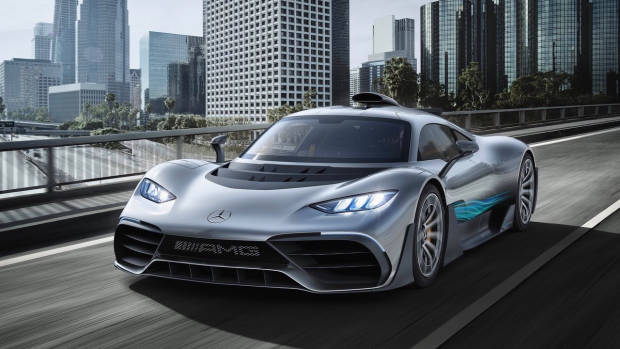
“Motorsport is not an end in itself for us. Faced with intense competition, we develop technologies from which our production vehicles also subsequently benefit. We are drawing on our experiences and successes from three constructors’ and drivers’ world championships to bring Formula 1 technology to the road for the first time: in Mercedes-AMG Project ONE”, says Dr Dieter Zetsche, Chairman of the Board of Management of Daimler AG and Head of Mercedes-Benz Cars.

The 1.6-litre turbocharged V6 engine used in the Project One has been derived from the engine used in Mercedes’ F1 car. The engine itself revs to around 11,000rpm, and produces “around 500kW” – both numbers are lower than the race car due to reliability concerns and the use of road going – not race – fuel. The motor itself features an electric turbocharger, which both eliminates turbo lag and is capable of storing unused energy in the car’s lithium-ion battery pack.
The Project One also features three electric motors – two 120kW units on the pure-electric front axle and a 90kW unit mounted on the turbocharger in the engine. In combination with the petrol engine, the Project One’s total combined output is listed as “over 1000hp” or 740kW. The Project One puts its power through an eight-speed automated manual transmission that was developed from scratch for the car.
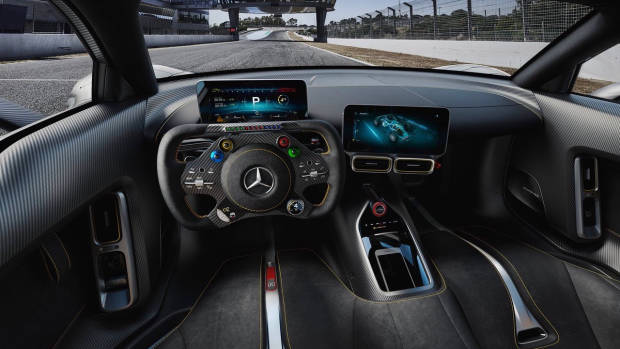
The electric side to the Project One’s performance is equally impressive, with each front electric motor capable of spinning at up to 50,000rpm – more than double previous highs of other electric cars. The car’s third electric motor is capable of spinning at up to 100,000rpm.
Particularly impressive are some of the claims that Mercedes-AMG are making about the Project One’s drivetrain – the car is supposedly capable of travelling 25km on electric power alone. The Project One’s thermal efficiency, thanks to its electric turbo and its electric motor on the crankshaft, is around the 40 percent mark – significantly improved compared to most production car levels of around 33 percent.
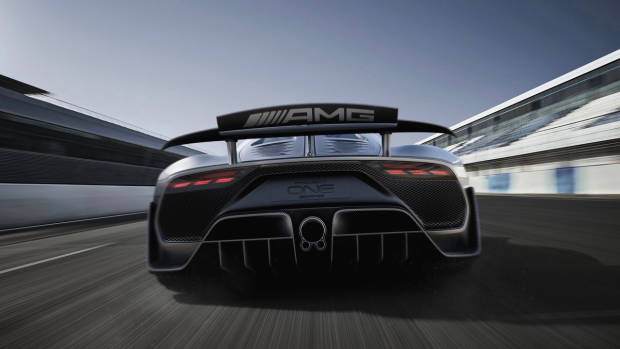
Previously, Mercedes-AMG confirmed that the Project One is capable of travelling over 217mph/350km/h, whilst today it was announced that the car will be capable of a 0-200km/h sprint of under six seconds – quicker than most cars get to even half that speed. Those numbers, by way of comparison, are quicker than the electric hypercar trio: the LaFerrari, Porsche 918 Spyder and McLaren P1 and even faster than the non-hybrid king of current hypercar speed, the Bugatti Chiron.
Both the front and rear suspension systems feature a multi-link setup with adjustable coilovers, while the electronic stability program (ESP) features three modes – including ESP sport and ESP off modes for track use. The Project One sits on forged 19-inch front and 20-inch rear wheels, with Michelin Pilot Sport Cup 2 tyres that were developed specially for the car. The wheels themselves feature a centre lock with a radial carbon-fibre semi-cover that Mercedes claims to optimise aerodynamics and airflow around the wheels.
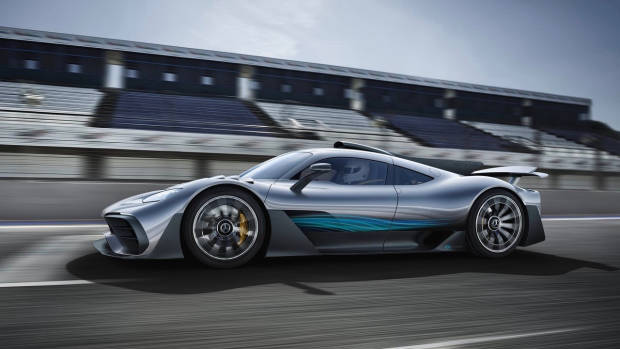
The design of the Project One is clearly unlike any Mercedes production car that has ever been produced – it’s visually and unashamedly wild, and even sports cues from the legendary McLaren F1. Designed with aerodynamics in mind, the front end of the Project One features a massive apron designed to suck in air and channel it around the car to aid performance – air from the side intakes is channeled out of the car’s side vents.
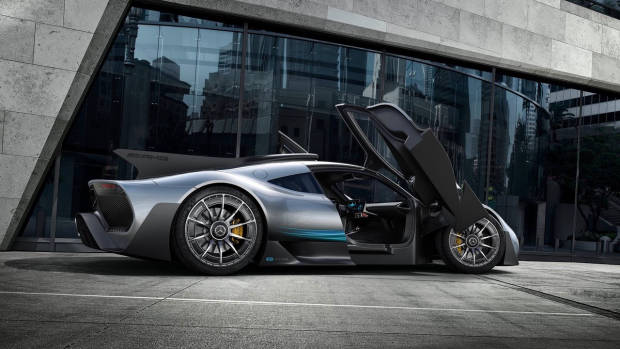
Derived from F1, sitting on top of the car’s cabin is an air intake that feeds air directly to the engine. The black intake transitions into a massive fin, which Mercedes claims aids stability in high-speed cornering. Sitting at the rear is a large rear wing, with a two-speed aerofoil to control airflow over the rear end at higher speeds. Like the front end, a massive apron features around the rear that incorporates a rear diffuser. While the details of the Project One are extreme, they are all designed to have as little aerodynamic waste as possible.
Inside the Project One is quite different to other Mercedes vehicles, with a refreshingly simple minimalist approach to functionality. The seats themselves are integrated into the floor and feature adjustable headrests that are built into the chassis, as well as both a steering wheel and pedals that are adjustable to a driver’s preference. Two high-res 10-inch displays – one replacing a traditional dials set up of a normal car, and one for the infotainment system mounted on the dashboard – continue the tablet-like interior design theme from other Mercedes models.
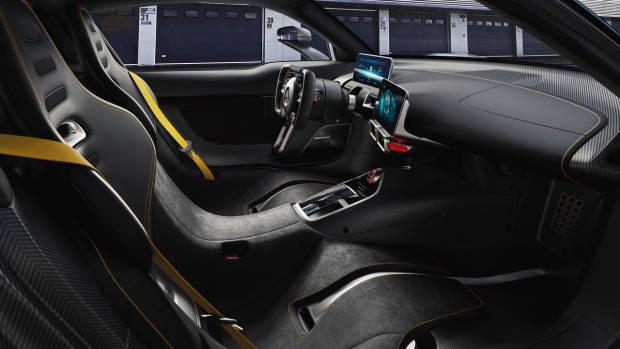
An F1-style steering wheel with flattened upper and lower sections has been fitted to the Project One with controls taken from the latest S-Class steering wheel. The upper portion of the wheel is fitted with LED upshift lights, and the door panels are finished in carbon fibre. Industrial-like air vents feature below the central screen and in the doors themselves. The Project One features no rear window, and instead uses a camera feeding an image into the rear view mirror for the “optimum rearward visibility”, according to Mercedes.
Perhaps most excitingly, Mercedes claims that technology used in the Project One will one day filter down to ‘regular’ AMG models. Just 275 units of the Project One have been confirmed for production, with eight combined units confirmed for Australian and New Zealand markets.
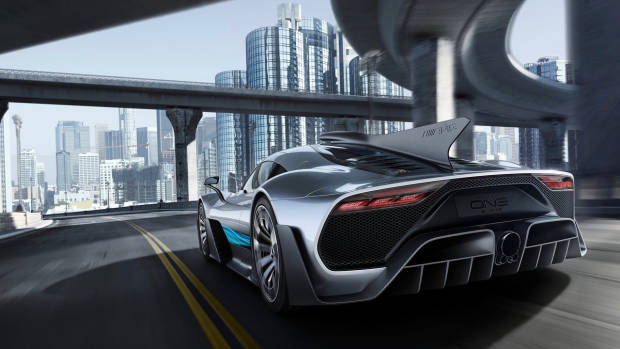
Stay tuned to Chasing Cars for news regarding the Mercedes-AMG range.
Latest news
About Chasing cars
Chasing Cars reviews are 100% independent.
Because we are powered by Budget Direct Insurance, we don’t receive advertising or sales revenue from car manufacturers.
We’re truly independent – giving you Australia’s best car reviews.